|
||||||||||
|
ARTICLESConfucius Institutes and Controlling Chinese LanguagesMichael Churchman The Australian National University*
The following article adds to the growing corpus of material related to New Sinology published by China Heritage Quarterly. A crucial aspect of our approach to Chinese Studies is how, in an age of prosperity for China and concomitantly Chinese Studies, diversity of approach and of understanding of 'things Chinese' can be fostered and protected. The present essay highlights issues related to 'Chinese language literacy' in the context of China's state-sponsored Confucius Institutes, Chinese language orthography and non-standard forms of Chinese, be they written or spoken. Previously we have noted the 2008-2009 debate in the People's Republic of China over the fate of non-simplified (that is 'complex' or 'traditional') Chinese characters (see the Editorial Comment at the end of the present essay). We have also published work related to 'China (and more broadly Asia) literacy' in Australia. See, for example, Michael Dutton and Deborah Kessler's 'Australia's Asia: An Illiterate Future?' (China Heritage Quarterly, Issue 19, September 2009), Edward McDonald's 'The “中国通” or the “Sinophone”? Towards a political economy of Chinese language teaching' (China Heritage Quarterly, Issue 25, March 2011); and, 'On a Chinese Studies Program', an excerpt from the historian Frederick W. Mote's China and the Vocation of History in the Twentieth Century, A Personal Memoir (2010), (China Heritage Quarterly, Issue 25, March 2011). The present essay is a further contribution to this broader discussion. Michael Churchman is a PhD scholar working on the history of the bronze-drum-making peoples of the Lingnan 嶺南 region of southern China during the Six Dynasties period (222-589CE).—The Editor A Mean Standard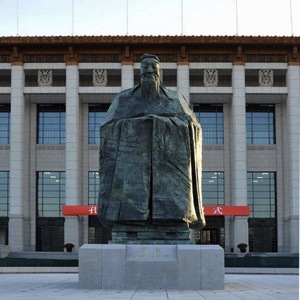 Fig.1 The statue of Confucius erected on the eastern side of Tiananmen Square in January 2011 and surreptitiously removed in April, the same year In late April 2011, a ten-metre high statue of Confucius was quietly removed from its prominent position outside the refurbished National Museum of China on the eastern flank of Tiananmen Square. Its appearance in January 2011 in a space associated since 1949 with the trenchant anti-Confucian politics of the Chinese Communist Party occassioned no small amount of comment. Although in form the ancient sage has been plucked from the heart of the People's Republic, the institutes that bear his name show no sign of emulating the mysterious disappearing act. Indeed, now over three hundred Chinese government-sponsored Confucius Institutes are operating worldwide. Educational institutions in numerous countries have had the carrot of a Confucius Institute and the funding opportunities that come with them temptingly dangled in front of them and numbers indicate that many have succumbed. The official reason given for the propagation of Confucius Institutes is that they promote interest in and appreciation for Chinese culture and language abroad; proliferation of Confucius Institutes is often mentioned against the backdrop of a larger effort to increase China's cultural 'soft power' worldwide. The logic of the foundation of Confucius Institutes is that encouraging non-Chinese to understand more about China and Chinese will lead them to develop more positive attitudes towards China itself. Other significant nation-states (France, Britain, Germany and Japan) have been funding similar projects for decades. The difference between the new Confucius Institutes and other state-backed institutions such as the Goethe Institute and the Alliance Française is that Confucius Institutes are founded within pre-existing international educational institutions; consequently there is a widely-held suspicion that these institutes are aimed less at fostering interest in China and Chinese culture itself, and more at ensuring that such interest is guided along lines approved of by the Chinese party-state. Much discussion has already taken place internationally concerning the potential of Confucius Institutes to stifle academic discussion in their home universities, in particular in relation to a long list of topics that the Chinese Communist Party finds unsuitable for discussion, such as the status of Taiwan, Tibet, Falungong, human rights, democratic reform and so on.[1] Given the current economic influence of the People's Republic of China one has to wonder why anyone needs to put money into encourage interest in that country. Interest in Chinese culture and language amongst non-Chinese has been growing steadily for the last three decades and it is understandable in the context of the growth of China's increased wealth and external political influence. Under such circumstances it is hard to imagine that the present fascination for things Chinese will dwindle back to the level it was in the 1970s when there were limited opportunities for trade and vexatious restrictions on visiting China. Aspects of Chinese culture that have long been attractive to outsiders (such as Chinese food and cooking, art, thought and philosophy, calligraphy, films, martial arts, and so on) are also unlikely to suddenly lose their popularity. The problem is that non-Chinese interest in things Chinese is not always in sync with the aspects of Chinese culture that the current Chinese polity deems acceptable. Racy products of the Hong Kong and Taiwanese entertainment industries, banned novels by Chinese writers, and the Dalai Lama are all highly popular outside China. These are unlikely to be harnessed to serve the soft power project of the mainland party-state. 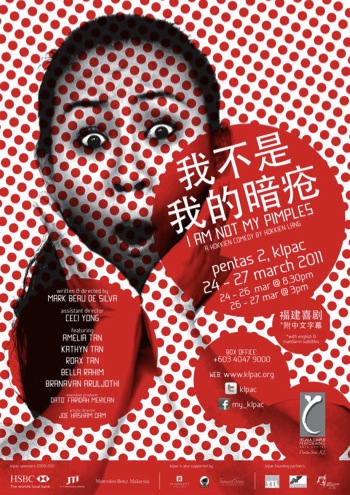 Fig.2 Poster for the Hokkien Stage Play 'Wah mm si wah eh jelawat' ('I am not my pimples') performed in Kuala Lumpur It is naïve to believe that Confucius Institutes are politically disinterested teachers imparting Chinese culture and language. They exist for the express purpose of letting foreigners understand China on terms acceptable to official China. The regulations by which the Confucius Institutes must abide already make it clear that teaching of knowledge about China will be subject to control, although it is noteworthy that whoever composed those regulations seems to have tried to make them appear as apolitical as possible.[2] There is no explicit rule banning the teaching of well-known sensitive political topics, for instance, but there is the phrase in the Sixth Principle of Section One of the Constitution and Bylaws of the Confucius Institutes (Kongzi Xueyuan Zhangcheng 孔子學院章程 /孔子学院章程) 'they shall not contravene concerning the laws and regulations of China [sic]',[3] which offers endless possibilities for prohibiting the discussion or teaching of any topic that is deemed objectionable. Where the guiding hand of Chinese officialdom is most evident, however, is in the Tenth Principle of the Confucius Institutes Constitution which stipulates: 'The Confucius Institutes conduct Chinese language instructions in Mandarin [Standard Chinese/Putonghua], using Standard Chinese Characters.' This is an extension to teaching institutes overseas of Article Twenty of the Language Law of the People's Republic of China promulgated in 2000 which states: 'Putonghua and the standardized Chinese characters shall be taught in classes for foreigners who are learning Chinese [sic]'.[4] This Tenth Principle is the only explicit evidence for the exclusion of certain subjects from the teaching syllabus of Confucius Institutes, but few commentators seem to have paid it much attention. The significance of the regulation, however, is clear: not only is it against the rules to teach any Chinese language other than Putonghua within a Confucius Institute, it is also forbidden to teach students the non-simplified characters still widely used in Taiwan, Macau, Hong Kong and many other Chinese communities beyond the direct control of the Chinese Communist Party. The reason why the most obvious interdiction covering subject matter in the Confucius Institutes has been so little discussed probably stems from the fact that although outsiders are always on the lookout for evidence that the Chinese party-state is trying to exercise control over prominent political issues, linguistic matters are generally regarded as being relatively insignificant. 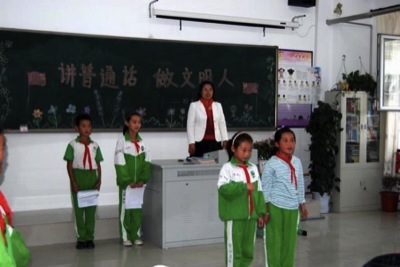 Fig.3 Teaching attitude in China: the writing on the blackboard reads 'Be Civilised, Speak Mandarin!' It is undeniable that learning Standard Chinese, or Mandarin, along with simplified characters is of great benefit for beginning students of Chinese, but the exclusion of other ways of speaking and writing Chinese should immediately raise suspicions. Perhaps the compilers of the regulations assumed that people would not question the status of Standard Chinese and simplified characters as the undisputed legitimate forms of Chinese speech and writing, and that such regulation would not be taken as a political move? If it really were the case that literacy in traditional characters and proficiency in Chinese languages other than Standard Chinese were completely irrelevant to the study of Chinese, there would be no demand for them, and indeed no need to legislate specifically against teaching them to non-Chinese or foreign-born 'heritage students'. It is true that as an undergraduate I heard fellow students and ethnic Chinese of various backgrounds wonder out loud why people would want to waste their time learning traditional Chinese script, literary Chinese, or Hokkien or Cantonese, when they could just concentrate on learning 'Modern Standard Chinese' (that is, standard People's Republic of China Putonghua written in simplified characters), but at the same time I knew students who wanted to study Cantonese rather than Mandarin and others who preferred to learn their Mandarin in traditional script. The directive 'You must not discuss the Dalai Lama' is bound to cause much more heated discussion outside China than 'You must not teach foreigners how to write the Chinese character 漢' but both statements are based on the same underlying principle, that is, how to encourage non-Chinese to extend their knowledge of China, but only in ways that the Chinese state finds acceptable. The control through Confucius Institutes of what can and cannot be taught as Chinese is as equally rooted in the politics of the People's Republic as the control of what can and cannot be discussed about China. It is by nature detrimental to a wider understanding of China as is the exclusion of certain censored topics. Promoting Semi-Literacy in ChineseThe trend towards literacy in Chinese based solely on simplified characters for non-native users of Chinese is hardly anything new. It is, not surprisingly, encouraged by the practical benefits of access to a larger market and the relatively small output of reading materials in the traditional script from Taiwan and Hong Kong. Many international students of Chinese regard the non-simiplified script as being a superfluous relic of the past and concentrate their energies on learning instead what they regard as 'Modern Chinese'. Unfortunately, it is still the case at present that a Chinese literacy restricted to simplified characters still only constitutes semi-literacy in Chinese. Knowledge of non-simplified Chinese is not restricted to the older generation in China. The literate younger generation of mainland Chinese are generally familiar with reading non-simplified Chinese script even if they cannot write it. This is a skill they gain through reading signs and inscriptions or subtitles on pirated DVD's and illegally downloaded films, as well as via reprinted books and texts of all kinds. So declining to teach traditional Chinese script to non-Chinese denies the learner an ability that many Chinese themselves have acquired unconsciously through long-term exposure. Training in at least recognition of the traditional script is essential for foreign learners, since most are not exposed to any written Chinese until later in life. The result of late and limited exposure to written Chinese in a non-Chinese speaking environment means that foreign learners are less familiar with the contexts of words, and therefore less likely than literate Chinese to be able to guess the simplified form of a character they have learnt in a traditional text, let alone find it in a dictionary. From an early stage in their studies, tertiary-level students of Chinese should be encouraged at least to be able to read and understand texts in the traditional script in addition to their reading materials in simplified Chinese. If they are not taught this skill they will have great trouble reading texts not only from Hong Kong and Taiwan, but also those from their own local Chinese communities, as many of these still print materials in the non-simplified characters. The most important reason for familiarity with traditional Chinese is the access it gives to texts published beyond the reach of the Chinese party-state, either from Hong Kong or Taiwan, or indeed from elsewhere. This is important in an era of globalisation in which much new knowledge production is being undertaken beyond the ken of China's officialdom. Many rich and detailed academic analyses of current events in China that are restricted or censored inside the People's Republic are only published in traditional characters. It is for this reason in particular that the importance of the traditional script to the study of contemporary China should not be underestimated. After all, what scholar of contemporary Chinese politics can afford to ignore (or be unable to read) the large and growing corpus of material on Communist Party history, infighting and factionalism written by mainlanders but published exclusively in Hong Kong and Taiwan? Or, for that matter, what competent sociologist, legal expert or historian can afford to be unable to read comfortably work published by leading thinkers and writers from the Chinese world censored at home but available outside the mainland? 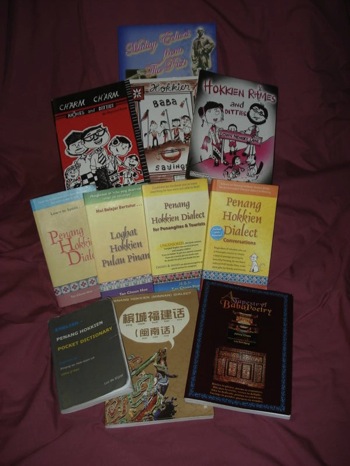 Fig.4 The author's collection of materials on Penang Hokkien Of equally great concern is the effect of semi-literacy on the informed study of the Chinese past. If students are not taught to read non-simplified/standardized characters or become familiar with the rudiments of the various kinds of Literary Chinese (Wenyan wen 文言文 or Guwen 古文) that have evolved from pre-Qin times,[5] they may have to forgo reading original sources. Relatively few simplified character editions exist for many works published before the late 1950s, and many other works which have been printed in simplified Chinese or translated into modern Mandarin come with ready-made interpretations based on the party-state's orthodox views of events and Chinese history. In contrast, many of the best editions of classical texts available in China itself are printed in the traditional script, as are many contemporary academic discussions of Chinese philosophy and history. In an ironic twist through the exclusion of traditional characters from the teaching syllabus, the Confucius Institutes will help non-Chinese students understand less about Confucianism by ensuring they have difficulty reading serious scholarship and pre-modern materials related to it. It is likely that the policy on teaching only simplified characters at Confucius Institutes is partly a reflection of the way Chinese language is taught inside the mainland education system itself, and partly of the conviction of the party leadership that the simplification of characters was one of their great contributions to the growth of a contemporary Chinese culture. However, one suspects that a major consideration in the drafting of the bylaw for the Confucius Institutes has been to set foreign learners on the 'correct' ideological path in their studies of China by making sure that texts in heterodox script from Taiwan and Hong Kong remain opaque, thereby creating a generation of China scholars who will feel perfectly comfortable dealing with a simplified China be it online or in print, but challenged by such media outlets as the Hong Kong Apple Daily, or the publications of a plethora of Hong Kong and Taiwanese publishers. Serious students of China need to be comfortable reading across many Chinese worlds. Challenging Mandarin Monoculture in Hong Kong, Malaysia and OnlineThe regulation limiting Chinese language instruction under the aegis of the Confucius Institutes to Standard Chinese might also seem unnecessary at first glance, simply because the utilitarian value of Mandarin would seem to have made other varieties of Chinese irrelevant to the contemporary world. But, surely, the inclusion of such a rule is in itself an admission that Standard Chinese has yet to score a total victory over other Chinese languages. I would expect that it is in particular directed at Cantonese. Unlike other Chinese languages[6] that have been beaten into submission by language planners and legislated out of popular culture, Cantonese remains the vigorous, vital international language, not only of Hong Kong but also of many overseas Chinese communities. Despite its smaller number of speakers in comparison to Standard Chinese there are still considerable numbers of people, Chinese and non-Chinese alike, who wish to learn it. Much of the popularity of Cantonese stems from the attractions of Hong Kong popular culture. Just as manga and anime have attracted many young people to the study of Japanese, the products of Hong Kong popular culture have proved to be major attractions to the study of things Chinese. Up until very recently, the Cantonese take on Chinese culture, be it in the form of martial arts films or Cantonese food was the Chinese culture with which most outsiders, at least those in Australasia, Europe and America, had their first significant contact. This was particularly true as recently as the 1990s. It is hardly surprising when one considers that the vast majority of mainland-produced films and TV series were at the time still formulaic pieces about heroic revolutionaries fighting the Kuomintang or the Japanese. It is notable that even the most recent films from the People's Republic that have enjoyed international popularity owe their origins more to the Hong Kong film industry than to China's lugubrious 'Red Classics'. 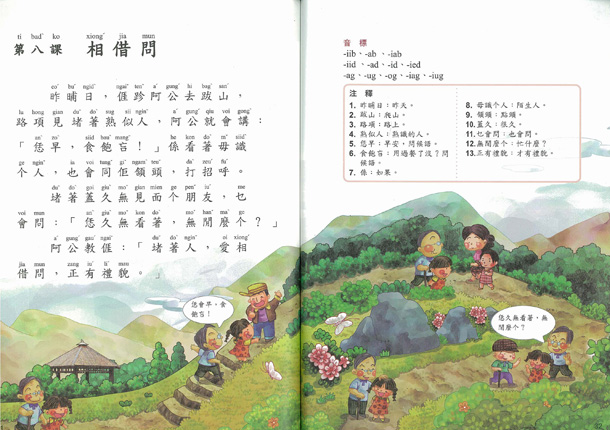 Fig.5 Sample pages from a Hakka textbook published by the Taiwanese Ministry of Education for use in primary schools. Click image to enlarge.
Confucius Institutes might do well to harness Cantonese popular culture to promote interest in China overseas, as it has already gained Hong Kong a considerable arsenal of soft power in its own right (and even within the People's Republic) without the deus ex machina of government subsidies. It would certainly appeal to a wide audience, but unfortunately, this is unlikely to happen. Hong Kong's status as a former colony, and as a freewheeling cultural entrepôt prevents it from fitting neatly into the mould of orthodox Chinese culture defined by Beijing. Hong Kong and Cantonese culture are instead often regarded as being aberrations, an exception to the 'mainstream' that is fated to be absorbed slowly back into the ways and workings of a greater China. The attitude of those who wrote the regulations for the Confucius Institutes seems to be that foreigners need to be weaned off the study of Chinese languages other than Standard Chinese. This is a projection outwards of similar attitudes towards speakers of non-standardised Chinese languages within the People's Republic itself, where banners and advertising hoardings promote the official attitude to local languages by exhorting the population to 'Be Civilised, Speak Mandarin!' (zuo wenming ren, shuo putonghua 做文明人, 说普通话!). The implied denigration of non-standardised languages as being somehow uncivilised and backward may work in moulding people's perceptions of their local languages in poorer areas of the country, but it is not particularly effective with Cantonese speakers. The identification of Cantonese with the cultural sophistication of Hong Kong and the higher socio-economic level of locals in Guangdong compared to that of Mandarin-speaking migrants mean that Cantonese in southern China is usually connected to ideas of higher social status and cosmopolitanism that the propagandists fondly hope to attach to Standard Chinese.[7] The emotional bond that Cantonese speakers have with their own language was illustrated in July and August 2010 when the discovery that the local government was planning to curtail the number of hours of Cantonese television programming in Guangdong caused organised protests against such a move.[8] Like the traditional Chinese script, Cantonese owes much of its currency within China to the illegal channels through which Chinese youth are forced to seek their entertainment. Legal copies of Hong Kong films and television programmes sold in the People's Republic must be dubbed into Mandarin, whereas the much wider variety of films for sale on the black market, or procured via downloading are usually available in their original language.[9] Through this exposure many young Chinese gain at the very least a passive knowledge of Cantonese, and some go on to learn to speak it fluently. For the moment at least Cantonese is safe from direct pressure in Hong Kong, and remains there the de facto language of everyday life and cultural production. Unless this changes, the popularity of Cantonese is unlikely to wane. Outside Mainland China and Hong Kong, Malaysia is another stronghold of Cantonese culture. Despite the fact that the Chinese-medium schools in Malaysia teach only Standard Chinese, Hong Kong popular culture and a large base of native speakers have combined to keep Cantonese the default language for the Chinese of Kuala Lumpur. Malaysia is a particularly interesting country as far as language use and attitudes among Chinese is concerned. Although it has a large population of ethnic Chinese, the government is largely ambivalent in regard to what language they speak amongst themselves and probably would prefer them to speak more English or more Malay. There is no government censorship regarding the daily linguistic habits of Chinese people, however, and no government-funded campaign to encourage people to speak Standard Chinese to each other. Unlike Singapore, or Taiwan where the force of government campaigns has resulted in large-scale language shift towards Standard Chinese (although people speak and speak of Huayu 華語 and Guoyu 國語), or (in the case of Singapore) still bars its citizens from watching television or films in any Chinese language other than the Standard, Chinese language use in Malaysia has developed organically without the interference of language planners. Consequently, there is little social stigma attached to speaking a non-standard Chinese language, as many highly educated Chinese speak their native Chinese language, as well as Malay and English, but not Putonghua. 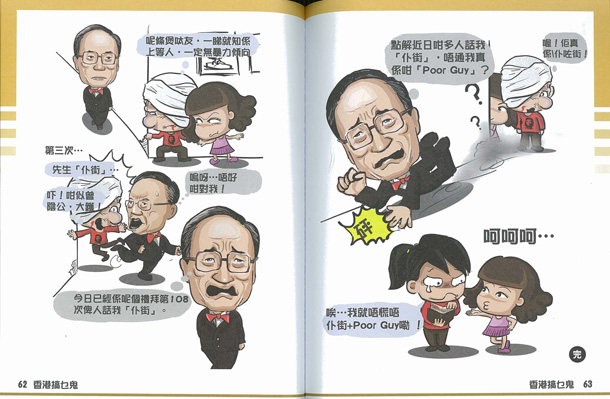 Fig.6 A page from Heunggong Gaau Mat Gwai 香港搞乜鬼 (What the Hell is Hong Kong up to?) a collection of political cartoons by Siu Si Moi 小師妹 and Leung Cheuk-kei 梁焯圻. Click image to enlarge.
This has ensured that many parents still speak to their children in their own languages rather than switching to Standard Chinese and it has created a generation of Chinese under thirty in Malaysia who have a higher level of proficiency in Hokkien and Cantonese than is the case in Singapore. They are also much more likely to converse in Hokkien with their peers than those of the same age in Taiwan. The fondness for non-Standard Chinese is not, however, universal and there is a noticeable shift towards speaking Standard Chinese or English in places like Penang. But rather than wholesale replacement of the languages by Standard Chinese as has happened in urban Taiwan, Singapore and many Chinese cities, the language shift amongst Malaysian Chinese consists of a reduction in skill level and increased code-mixing with English, Malay or Standard Chinese to make up the shortfall in vocabulary. Despite the obvious commercial advantages offered by proficiency in Standard Chinese and English, the diminution of non-Standard Chinese languages and the example of language shift amongst the neighbouring Singaporean Chinese have led many Malaysian Chinese to question publicly why they need to become monolingual in Standard Chinese. Having met Singaporean and Taiwanese Chinese raised in Standard Chinese-only environments and who are unable to enjoy anything but the most basic communication with their grandparents, I began to wonder 'How do you learn about your heritage using a language that was never spoken by your own ancestors?' Overseas Chinese are beginning to ask themselves the same question. There are a number of factors that have encouraged interest in these languages in Malaysia. One is the higher standard of living enjoyed by Malaysian Chinese: there exists a highly educated class of people already proficient in English that now has the means and the leisure to develop an interest in the heritage of its forebears. Although this interest leads many to the study of Standard Chinese, others are attracted to Cantonese or the languages that are (or were) actually spoken by members of their own families. Another factor is the spread into Malaysia of cultural works from Taiwan in Hokkien and Hakka. Since the late 1980s in Taiwan there have been no restrictions on the use of language in the media. This does not seem to have had much of an effect on the language that young Taiwanese speak amongst themselves (which is usually a version of Standard Chinese), but cultural products such as Hokkien and Hakka pop songs, films, and TV series have had a positive effect on people's perceptions, in a similar way that the popular culture of Hong Kong has had for Cantonese. The inhabitants of Penang have a particular fondness for their local version of Hokkien, which has recently led the language out of traditional settings such as religious ceremonies and Chinese operas to new uses by a younger generation. John Ong, a Malaysian Chinese living in the United States began a popular weekly podcast in Penang Hokkien that has been running now for over five years and has listeners and participants not only from Penang and Northern Malaysia but from the many parts of the world where Penangites live.[10] The last ten years have also seen the publication of eleven books and dictionaries on the subject of Penang-style Hokkien,[11] and in the last year there have been public performances of two modern stage plays in Hokkien at the Kuala Lumpur Performing Arts Centre, the most recent being 'Wah mm si wah eh jelawat' ('I am not my pimples').[12] Apart from Cantonese and Hokkien, other Chinese languages in Malaysia are in a less fortunate position as they have fewer speakers and geographically scattered populations. But, even a much smaller language like Hainanese has a dedicated company of talented singers and actors who sing and perform plays in Malaysian Hainanese.[13] In the wider world the Internet has provided a new avenue for those who wish to study or to promote the study of non-Standard Chinese languages. Even five years ago it was extremely difficult to find teaching materials for Chinese languages other than Standard Chinese or Cantonese. The materials that did exist mostly consisted of dictionaries and textbooks written by missionaries before the outbreak of the Pacific War. Rare copies of such works sat forgotten and gathering dust on the shelves of university libraries, but now many have been digitised and placed online by enterprises such as the Internet archive,[14] or offered by enthusiasts for a specific language, such as Gnudoyng's resources for the vernacular of Fuzhou.[15] In addition to these older materials there are also websites promoting the study of many different languages that include discussion forums and materials such as scientific descriptions, dictionaries, wordlists and sound files. 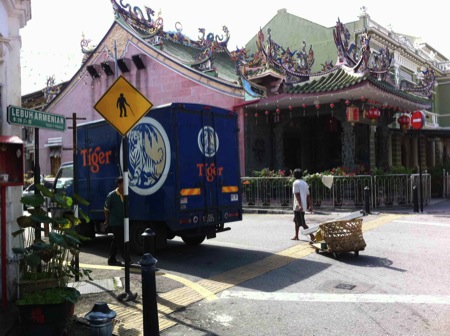 Fig.7 A street scene in Georgetown, Penang. (Photograph: GRB) American Chinese have compiled blogs in which they have posted old textbooks, wordlists, and learning materials for the Sze Yap 四邑 variant of Cantonese, once the undisputed Chinese language of US and Canadian Chinatowns. The US-based website Gaginang (家己儂 meaning 'our own people') provides an online dictionary and forum for the discussion and learning of Teochew (潮州 Chaozhou) Chinese.[16] As well as sites that presume no prior knowledge of Standard Chinese, there are many China-based websites designed for people who wish to learn the languages spoken in Suzhou,[18] Hainan,[19] as well as Hakka[20] and various varieties of Min,[21] not to mention the government-supported websites from Taiwan which provide free Hakka teaching materials.[22] The number of sites based in mainland China indicates that there is considerable interest in local Chinese languages, despite their exclusion from the state education system. The foregoing should at least provide some idea of the interest in and enthusiasm that exists for Chinese languages other than Standard Chinese. In terms of population many of these languages have more speakers than many national languages such as Polish, Dutch or Swedish, and their users are spread widely throughout the world. In urban Australia Standard Chinese is definitely the most commonly spoken language amongst Chinese, but (depending where you are) one can overhear conversations in Cantonese almost daily, Shanghainese conversations perhaps weekly, and bump into native speakers of Hokkien every few weeks. With the numbers and spread of speakers, it should not be surprising that Chinese and some non-Chinese have a use for non-Standard Chinese languages for business and pleasure and still consider them an interesting and useful subject of study. The fact that these languages are still popular and that there is still some demand for them (particularly Cantonese) must really irk those in China who wish to promote their own version of Standard Chinese as the world's only legitimate Chinese language. This is the underlying reason for the written regulation ensuring that non-Standard Chinese languages are never taught in the classrooms of Confucius Institutes.[23] The Costs of UnderfundingAlthough it is true that China is a vast and varied field of study, and even within the confines of People's Republic censorship there are topics for discussion and study to last many lifetimes. However, Chinese Studies should never have to be confined to subjects that one particular Chinese regime defines as appropriate, nor should the teaching of Chinese language be similarly restricted. It can and should always be much more than that. Chinese languages are far more rich and diverse than the single version taught by Hanban 漢辦/汉办 (the PRC's language teaching authority) and tested in the HSK (Hanyu Shuiping Kaoshi 漢語水平考試/汉语水平考试). Non-Chinese speakers should have the chance to learn as many and varied versions of Chinese and Chinese languages as possible and not be limited by the restrictive language policy current in China. The language policy enshrined in the by-laws of the Confucius Institutes is a clear indication that what is taught in the Institutes must conform to standards of what is politically acceptable to Beijing officialdom. Since the Confucius Institutes are partly funded by China, Beijing is quite entitled to stipulate what can and cannot be taught in them. 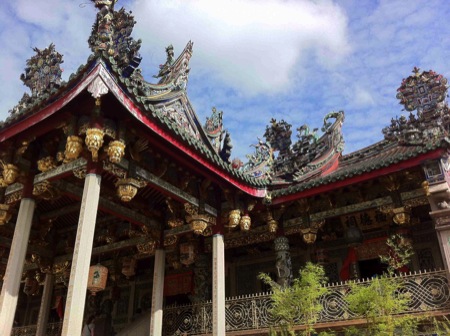 Fig.8 Khoo Kongsi 檳城龍山堂邱公司 family temple, Georgetown, Penang. (Photograph: GRB) At present the Confucius Institutes usually operate separately within universities and they would appear to have little influence on the content of undergraduate teaching. Universities can and still do continue to teach what they wish in their undergraduate Chinese Studies courses independently of the Confucius Institutes. The regulations on language teaching should serve as evidence that there are deeper implications to the acceptance of a Confucius Institute that any institution offering courses in Chinese Studies needs to carefully consider before entering into a pact that allows a Confucius Institute to initiate its operations on its campus. Were they independent organisations like the British Council or the Alliance Française, restrictions on teaching content would not be so disturbing but the danger of having such institutes incorporated into university structures is that over time universities may start to rely on them for Chinese language programs and China-related courses. Unfortunately, in most countries tertiary education in the humanities is increasingly strapped for funding, and in the environment of market-driven education, one in which universities are encouraged increasingly to seek private funding, the future of the independence of Chinese is not necessarily bright. When adequate funding to conduct teaching and research is unavailable, there is a danger that in the future Chinese language instruction and China-related classes will simply be farmed out to the staff of the Confucius Institutes. If this were to occur it would have a deplorable effect on the content of undergraduate teaching, possibly limiting it to subjects deemed more acceptable to the Chinese authorities, or lead to the exclusion of teachers who might hold and express alternative views. The very possibility of that happening should encourage academics and educators to keep Confucius Institutes at arm's length. If free discussion, research and teaching on aspects of Chinese life and culture that the Chinese party-state finds unpalatable cannot be carried out within the borders of China, then it is the responsibility of those who teach about China outside those borders to provide a sanctuary in which such things can thrive, not merely to replicate the regime's positions and views. If teaching and research about things Chinese outside China is forced through the spread of Confucius Institutes into universities to be at the beck and call of the Chinese state, we will all end up understanding less about China rather than more, much to the impoverishment of Chinese Studies worldwide. Related material from China Heritage Quarterly:
Editorial Comment:
In the Updates for the March 2009 issue of China Heritage Quarterly, I wrote a short report regarding the then-recent debates over traditional vs. simplified Chinese characters. As this material is not at present in the Quarterly Online Archive, I reproduce it here.—The Editor The Chinese Character—no simple matterIn early March 2009, delegates to the National People's Political Consultative Congress in Beijing argued over whether the state should move to reintroduce traditional-style Chinese characters. The Chinese written language was standardised and its orthography simplified during the 1950s and 60s as part of the socialist transformation of China under the Communist Party. Pan Qinglin 潘慶林, a representative of the congress from Tianjin who is involved with united front work and Chinese expatriates, called for a ten-year plan to reintroduce traditional or full Chinese characters. An immediate and vocal opponent was Wang Liqun 王立群 of Henan University who spoke of the virtues of the simplified forms. The first proposal of recent mainland provenance in favour of replacing the simplified forms of Chinese characters was made the previous year by Wang Gan 王干, the editor of Selected Readings in Chinese Literature (Zhonghua wenxue xuankan 中華文學選刊), which is produced by the People's Literature Publishing House. On 2 February 2008, Wang posted a blog essay entitled 'What about abandoning simplified characters over the next half century?' (Wushi nian nei, feichu jianhuazi ruhe 五十年内,废除简化字如何.). Attempts to either simplify or romanize the Chinese language long predated the rise of the Communist Party and its particular Soviet-inflected modernizing ethos. However, the first formal and legally enforceable list of simplified characters was promulgated on 31 January 1956. It is known as the Hanzi Jianhua Fang'an 汉字简化方案. The aim of that move was far more revolutionary than is now generally recognized, for the preamble to the proposal declared that the simplifications were merely the first step towards the ultimate abolition of Chinese characters and their replacement with a spelling system that would be in accord with 'accepted international practice'. Needless to say, this aspect of the policy has remained dormant for over half a century. The simplifications did not merely reduce the number of strokes that make up certain characters, but in many cases replaced a variety of characters with a similar orthography but different meanings with one standard written form. This reduction of complexity and nuance has a continuing impact on how non-contemporary Chinese texts are read, and appreciated. Similarly, alternate readings of characters that had developed over the centuries and in different parts of the territory of the modern People's Republic were, and continue to be, restricted. This causes confusion within the Sinophone world, a sphere by no means limited to the People's Republic of China, but one that extends importantly to Taiwan, Hong Kong and numerous international communities. Forced standardization and simplification serves various political and cultural purposes which are often inimical to diversity. Today, the advocates in favour of returning to the traditional forms of Chinese characters argue, among other things, that the 1956 simplifications were crude and ill-judged, both aesthetically and linguistically. One favourite example is that of the character for 'love', 愛ai, the simplification of which—爱—has expunged the 'heart' 心 from the traditional character and replaced it with 'friend' 友. Critics lambast the simplified form for denoting 'heartless love'. Another reason to reintroduce complex characters, it is argued, is that with the increased use of computers, literacy does not depend on simplifications. Thirdly, it is claimed that the universal use of simplified characters would make it easier over time for the People's Republic and the Republic of China to be united. In his 2008 article, Wang Gan had also remarked that the traditional form of written Chinese was the soul of the nation's culture and literature, and to have abandoned them had been culturally counterproductive. Those in favour of the status quo argue that the simplifications are now universally recognized in mainland China and that to replace them with the older forms would be difficult and result in unnecessary and time-wasting confusion. Then there are those who believe that both forms should co-exist. The issue of vertical and horizontal printing does not seem to have been a major issue. On 12 March 2009, Zhang Xinsheng 章新胜, the vice-minister of education, along with a number of prominent educators took up the cause when speaking to journalists covering the congress. They defended simplified characters and in a legalistic tone of high dudgeon they declared that, since the simplifications were protected under the law, there would be no change. Meanwhile, China's Confucius Institutes, an officially supported network of educational endeavours aimed at inculcating the language and culture of China as interpreted in the People's Republic internationally, will continue to teach the simplified characters. Of course, for those educated solely in simplified characters, and therefore literally 'unlettered', the grand corpus of pre-1960s Chinese literature, history and print culture can prove to be challenging if not unreadable. Internet opponents to the reintroduction of traditional characters were far more vociferous that official spokespeople like Zhang Xinsheng. They called the fixation on the Chinese writing system to be of little relevant to the pressing problems facing the country today. Others remarked that the traditionalists represented a historical reversal and retrogression. 'While we're at it,' remarked one blogger testily, 'why not go back to wearing scholars' gowns?'. In China Heritage Quarterly we employ a mix of simplified and traditional characters, depending on the subject matter under discussion.—Geremie R. Barmé For sources related to the 2008-2009 discussion over the fate of Chinese characters, see:
首次提出“废除简体字”建议的不是潘庆林,而是人民文学出版社《中华文学选刊》执行主编王干。2008年3月2日,他以《五十年内,废除简化字如何》为题写了篇博客。See http://blog.sina.com.cn/s/blog_47458e6501008kwi.html Notes:* The author would like to thank the editor of China Heritage Quarterly for his invitation to write this essay, and for his editorial suggestions and additions to the original draft. [1] For recent discussions, see Glenn Anthony May, 'Confucius on the Campus', online at: http://www.asiasentinel.com/index.php?option=com_content&task=view&id=3035&Itemid=206; Justin Norrie, 'Confucius says school's in, but don't mention democracy', online at: http://www.smh.com.au/national/education/confucius-says-schools-in-but-dont-mention-democracy-20110219-1b09x.html [2] http://english.hanban.org/kzxy_list.php?ithd=xyzc [3] In the Chinese version this is: 不得与中国有关法律相抵触 ('may not contravene the relevant laws of China'. For the Constitution, see: http://www.chinese.cn/college/article/2009-08/24/content_12165.htm. [4] 对外汉语教学应当教授普通话和规范汉字. See: http://www.gov.cn/english/laws/2005-09/19/content_64906.htm. The terminology of these regulations deserves a brief comment: finally someone has given in to the fact that 'Mandarin' is the ordinary English term for 'Putonghua' even though it is an unword in the contrived English of the PRC education system; 'Standard Chinese characters' refers to what in the rest of the world usually is usually known as simplified characters, which not only include simplified versions of Chinese characters (many of which are based on earlier variants or hand-written versions of characters), but also standard readings (variant readings, and even interpretations of some characters are generally outlawed) and an enforced reduction of orthographic diversity. [5] It is unclear whether the teaching of 'Standard Mandarin' precludes the teaching of Literary Chinese, since this can be written in the simplified script. [6] Note that I do not follow the convention of referring to non-Mandarin Chinese with the English term dialect. Dialect is not an accurate translation of the Chinese word fangyan 方言, as it excludes standard varieties and implies a dichotomy of 'standard language versus dialect'. This is absent from modern English linguistic scholarship, which uses the term dialect to refer to any variation of language, standard or otherwise, meaning it is also possible to speak of Standard Mandarin as a 'Chinese dialect'. In any case, not all Chinese speakers use the term fangyan in the way it is used officially in Singapore and the People's Republic of China. In Taiwan, Hokkien and Hakka have been officially known as xiangtu yuyan 鄉土語言 or 'local languages' for over a decade. [7] Shanghainese holds a similar high-status language in its own city, dividing the richer locals from those who have come to seek their fortune in the city, but it has less chance of long-term survival than Cantonese. It has a minimal level of cultural production, and continued government pressure to eradicate in from the classroom and schoolyard has already caused significant language shift in younger generations and may eventually lead to its disappearance even as a home language in the next few decades. (For a lament on this subject, see Xu Jilin 许纪霖, 'Shanghai Culture Lost' 上海:城市风情依旧,文化何处寻觅?, China Heritage Quarterly, Issue 22, June 2010.—Ed.) [8] See, for example: http://blogs.wsj.com/chinarealtime/2010/07/30/backlash-for-cantonese-protests/; and, http://www.reuters.com/article/2010/08/02/us-china-protest-language-idUSTRE6710FM20100802. [9] As an example of this, ANU library recently made the mistake of ordering a collection of Shaw Brothers films from a supplier in Guangzhou, only to find that not one of them had its original Cantonese soundtrack. [10] Vide http://penanghokkien.com . See also the recent interview with John Ong in the Kwong Wah Jit Po 光華日報, online at: http://www.kwongwah.com.my/supplement/2011/06/07/4.html. [11] These are Tan Choon Hoe's four self-published books Learn to Speak Penang Hokkien Dialect (2001), Loghat Hokkien Pulau Pinang (2006), Penang Hokkien Dialect for Penangites and Tourists (2008) and Penang Hokkien Dialect Conversations (2010); Cheah Cheng Seang's Penang Hokkien (Minnan) Dialect (Penang Hokkien Association, 2010); Raymond Kwok's self-published Hokkien Rhymes and Ditties (2004), Hokkien Baba Sayings (2005), Ch'arm Ch'arm Rhymes and Ditties (2005) and Malay Echoes from the Past: Penang Hokkien Baba Language (2006); Johnny Chee's self-published A Tapestry of Baba Poetry (2006); and, Luc de Gijzel's Penang Hokkien Pocket Dictionary (Areca Books, 2008). [12] http://stagekl.com/shows/i-am-not-my-pimples/ [13] http://www.suukeemai.com/display/latest.php. This group performs in the Bunchio 文昌 variety of Hainanese commonly spoken throughout Southeast Asia. [14] Examples for Teochew (Chaozhou) are: A Handbook of the Swatow Vernacular (1886), online at: http://www.archive.org/details/cu31924023551306 ; English-Chinese Vocabulary of the Vernacular or Spoken Language of Swatow (1883), see: http://www.archive.org/details/englishchinesev00duffgoog ; and, English and Chinese dictionary of the Amoy dialect (1883), at: http://www.archive.org/details/cu31924023550878. [15] http://gnudoyng.net/fuzhou_dialect/resources.php [16] See http://ipracticecanto.wordpress.com/toishanese-textbook-audio/; also http://taishanese.blogspot.com/2011_05_01_archive.html [18] http://www.suzhouhua.org/home/ [19] http://hainaneseonline.blog.china.com/ [20] http://www.hakkaonline.com/forum/forum-forumdisplay-fid-32.html [21] http://www.ispeakmin.com/bbs/ [22] http://www.hakka.gov.tw/np.asp?ctNode=1738&mp=1722&ps= [23] I have excluded from discussion thus far the non-Sinitic minority languages such as Uyghur, Tibetan and Mongolian. Even though these have official status in the PRC, and their speakers within the borders of the People's Republic are (officially at least) considered just as Chinese as those who speak Sinitic languages. It is hard to imagine that the Confucius Institutes will ever be used to teach them to foreigners. If this seems a pedantic point, it is worth noting that the British Council has a programme to teach Welsh in Patagonia (http://www.britishcouncil.org/wales-education-welsh-language-project.htm) and that the Instituto Cervantes (Cervantes Institute) 'considers the coexistence in Spain of various languages one of Spain's most important cultural assets' and arranges Basque, Catalan, or Galician courses subject to demand (http://sidney.cervantes.es/en/courses_spanish/spanish_special_courses.htm). |